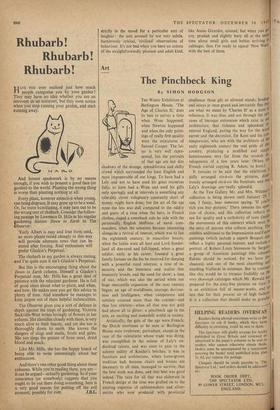Art
The Pinchbeck King
By SIMON HODGSON THE Winter Exhibition at Burlington House, 'The Age of Charles II,' does its best to survey a time when Wren happened, when Newton happened and when the only paint- ings of really first quality were the miniatures of Samuel Cooper. The lat- ter is very well repre- sented, but the portraits of that age are but dim shadows of the strange, splendiferous and shifty crowd which surrounded the least English and most impenetrable of our kings. To have had a Lely and not to have used his great resources fully, to have had a Wren and used his gifts only sparingly and at intervals is something any tolerably clever voluptuary constantly short of money might have done; but the art of the age none the less was dull compared to the oddity and gusto of a time when the hero, in French clothes, staged a comeback side by side with the perennially English bluffness of naval com- manders, when the scientists became interesting alongside a revival of interest, which was to last the eighteenth century, in masculine beauty, when the ladies were all bust and Lord Sunder- land all doe-eyed and full-lipped, when a great soldier, early in his career, founded a great family fortune on the fee he received for sleeping with a powerful royal mistress; a time of in- security and the bitterness and malice that insecurity breeds, and the need for show; a time of war, which was also the period when our huge mercantile expansion of the next century began; an age of worldliness, courage, devious- ness and intelligence, when competence and subtlety counted more than the content—and thus lost subtlety—when all that was not gold had above all to glitter; a pinchbeck age in the arts, an exciting and makeshift world in society.
Artistically, the guts of the age were French; the Dutch overtones to be seen at Burlington House were irrelevant; portraiture, except in the case of the miniaturist whose trade was dying, was exemplified in the misuse of Lely's un- doubted talents, and was soon to pass to the solemn nullity of Kneller's botches; it was in furniture and architecture, where home-grown tradition had, because chairs and houses are necessary to all men, managed to survive, that the best work was done, and that best was good indeed. The taste for all that was elaborate in French design at the time was grafted on to the existing expertise of cabinetmakers and silver- smiths who now produced with provincial
ebullience those gilt or silvered stands, firedal and inlays at once grand and intricately fine that, are what we mean by 'Charles II' as a term 01 reference. It was thus, and not through the We cases of baroque extremism which exist in okli architecture, that richness and splendour re: entered England, paving the way for the w000 carver and the decorator, for Kent and his al' temporaries, who are with the architects of the early eighteenth century the real pride of this country, producing a modified and simple luxuriousness very far from the modish de. velopments of a few years later. (When the French started copying R. Adam, to boot.) , It remains to be said that the exhibition ii dully arranged vis-a-vis the pictures, dis3s. trously arranged vis-a-vis the furniture, and thlt Lely's drawings are -really splendid. At the Tate Gallery Mr. and Mrs. WhitneY's collection is being shown until January 29%1 can, I fancy, hear someone saying, 'If yoU re rich you buy pictures.' There remains the clues. lion of choice, and this collection reflects .an eye for quality and a catholicity of taste (inside the movements of this century) which must V the envy of anyone who collects anything. The exhibits additional to the Impressionist and Fauve paintings (which include a superb Braque) als° reflect a highly personal interest, and include 3 portrait of Robert Louis Stevenson by Sargent. a group of American paintings (the admired Eakins should be noticed, for we have fevi, chances), and one of the most absorbing an° touching Vuillards in existence. But to continue like this would be. to trespass foolishly on the very thorough catalogue which Mr. Rewald has prepared for the sixty-five pictures on view. It is an exhibition full of master-works, and nd less that for their present air of high fashion' It is a collection that should make us gratefill'


































 Previous page
Previous page